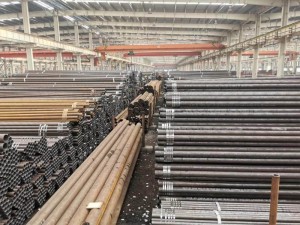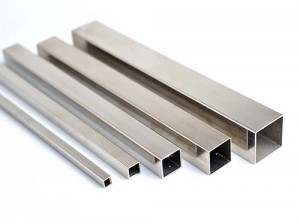Seamless steel pipes are in stock
Steel pipe is not only used for conveying fluid and powdery solids, exchanging heat energy, manufacturing mechanical parts and containers, but also an economic steel. Using steel pipe to make building structure grid, pillar and mechanical support can reduce weight, save metal by 20 ~ 40%, and realize industrialized and mechanized construction. Manufacturing Highway Bridges with steel pipes can not only save steel and simplify construction, but also greatly reduce the area of protective coating and save investment and maintenance costs. Steel pipes can be divided into two categories according to production methods: seamless steel pipes and welded steel pipes. Welded steel pipes are referred to as welded pipes for short.
1. Seamless steel pipe can be divided into hot rolled seamless pipe, cold drawn pipe, precision steel pipe, hot expanded pipe, cold spinning pipe and extruded pipe according to the production method.
Seamless steel pipe is made of high-quality carbon steel or alloy steel, which can be divided into hot rolling and cold rolling (drawing).
2. Welded steel pipe is divided into furnace welded pipe, electric welding (resistance welding) pipe and automatic arc welded pipe due to different welding processes. Due to different welding forms, it is divided into straight seam welded pipe and spiral welded pipe. Due to its end shape, it is divided into circular welded pipe and special-shaped (square, flat, etc.) welded pipe.
Welded steel pipe is made of rolled steel plate welded by butt joint or spiral seam. In terms of manufacturing method, it is also divided into welded steel pipe for low-pressure fluid transmission, spiral seam welded steel pipe, direct rolled welded steel pipe, welded steel pipe, etc. Seamless steel pipe can be used for liquid and gas pipelines in various industries. Welded pipes can be used for water pipelines, gas pipelines, heating pipelines, electrical pipelines, etc.
The mechanical property of steel is an important index to ensure the final service performance (mechanical property) of steel, which depends on the chemical composition and heat treatment system of steel. In the steel pipe standard, according to different service requirements, the tensile properties (tensile strength, yield strength or yield point, elongation), hardness and toughness indexes, as well as the high and low temperature properties required by users are specified.
The maximum force (FB) borne by the specimen during tension, divided by the original cross-sectional area (so) of the specimen(σ), Called tensile strength (σ b), in N / mm2 (MPA). It represents the maximum ability of metal materials to resist failure under tension.
For metal materials with yield phenomenon, the stress when the specimen can continue to elongate without increasing (keeping constant) the stress during the tensile process is called the yield point. If the stress decreases, the upper and lower yield points shall be distinguished. The unit of yield point is n / mm2 (MPA).
Upper yield point (σ Su): the maximum stress before the yield stress of the sample decreases for the first time; Lower yield point (σ SL): the minimum stress in the yield stage when the initial instantaneous effect is not considered.
The calculation formula of yield point is:
Where: FS -- yield stress (constant) of the sample during tension, n (Newton) so -- original cross-sectional area of the sample, mm2.
In the tensile test, the percentage of the length increased by the gauge length of the sample after breaking to the original gauge length is called elongation. with σ Expressed in%. The calculation formula is: σ=( Lh-Lo)/L0*100%
Where: LH -- gauge length after sample breaking, mm; L0 -- original gauge length of sample, mm.
In the tensile test, the percentage between the maximum reduction of the cross-sectional area at the reduced diameter and the original cross-sectional area after the specimen is broken is called the reduction of area. with ψ Expressed in%. The calculation formula is as follows:
Where: S0 -- original cross-sectional area of sample, mm2; S1 -- minimum cross-sectional area at the reduced diameter after sample breaking, mm2.
The ability of metal materials to resist the indentation surface of hard objects is called hardness. According to different test methods and application scope, hardness can be divided into Brinell hardness, Rockwell hardness, Vickers hardness, shore hardness, microhardness and high temperature hardness. Brinell, Rockwell and Vickers hardness are commonly used for pipes.
Press a steel ball or cemented carbide ball with a certain diameter into the sample surface with the specified test force (f), remove the test force after the specified holding time, and measure the indentation diameter (L) on the sample surface. Brinell hardness number is the quotient obtained by dividing the test force by the spherical surface area of the indentation. Expressed in HBS (steel ball), unit: n / mm2 (MPA).
Where: F -- test force pressed into the surface of metal sample, N; D -- diameter of steel ball for test, mm; D -- average diameter of indentation, mm.
The determination of Brinell hardness is more accurate and reliable, but generally HBS is only applicable to metal materials below 450N / mm2 (MPA), not for hard steel or thin plates. Brinell hardness is the most widely used in steel pipe standards. Indentation diameter D is often used to express the hardness of the material, which is intuitive and convenient.
Example: 120hbs10 / 1000 / 30: it means that the Brinell hardness value measured by using a 10mm diameter steel ball under the action of 1000kgf (9.807kn) test force for 30s is 120N / mm2 (MPA).








